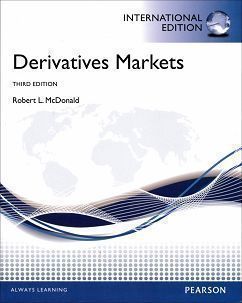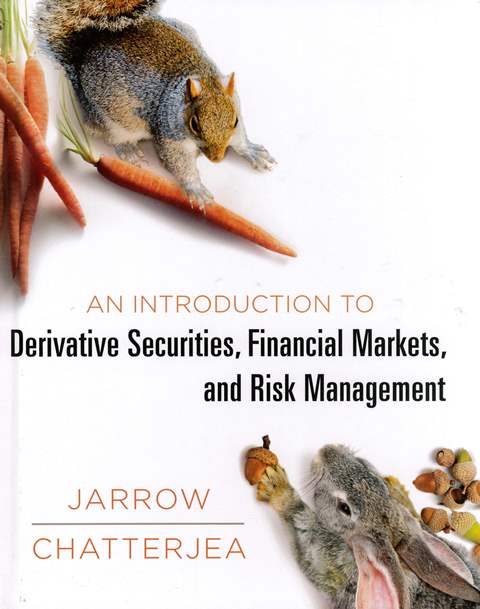書籍分類

Derivative Markets 3/e
作者:Robert L. McDonald
原價:NT$ 1,300
ISBN:9780321847829
版次:3
年份:2013
出版商:Pearson Education
版次:3
年份:2013
出版商:Pearson Education
內容介紹 本書特色 目錄
- Description
To be financially literate in today’s market, business students must have a solid understanding of derivatives concepts and instruments and the uses of those instruments in corporations. The Third Edition has an accessible mathematical presentation, and more importantly, helps students gain intuition by linking theories and concepts together with an engaging narrative that emphasizes the core economic principles underlying the pricing and uses of derivatives.
The third edition has been updated to include new data and examples throughout.
- Features
- Concrete Applications complement the pricing discussions. Chapters on financial engineering, corporate applications, and real options all address practical problems.
- An emphasis on core economic principle shelps students develop a deeper, more intuitive understanding of derivatives markets and instruments. For example, the idea that options are a form of insurance is presented at the outset.
- Integrated treatment of forward contracts and options. The initial chapters cover both forwards and options, illustrating how they are used and incorporating an extended example of hedging by gold-mining and gold-buying firms. This approach helps to unify option pricing; in particular, it makes it clear that the formula for pricing stock options is the same as the formula for pricing currency options.
- Formulas are motivated, placed in context, and explained intuitively. The goal is to help students build intuition about pricing models through their applications so they can know when a price does not make sense and why. The author provides the student with a framework for thinking about commonality among various derivative instruments.
- The Theme of Applied Computation is emphasized.Using the pre-programmed Excel spreadsheets that are packaged with the book, students can become more comfortable and fluent with pricing models and their use in spreadsheets, even before they understand the precise mathematical underpinnings.
- James Carville on derivatives; prediction markets; Bernie Madoff; hedging and Southwest Airlines; Forbidden Futures; tanker-based arbitrage; LIBOR during the financial crisis; repo during the financial crisis; Islamic finance; the Bank Capital debate; Google and compensation options; Warren Buffet’s written put options; Hedging the PBGC’s liabilities; black swans; standardizing CDS; Government credit guarantees; structured finance and the financial crisis; Abacus and Magnetar; and more.
-
New chapter 22. This new chapter emphasizes the economic underpinnings of option pricing and explains more general variations on risk-neutral pricing. A discussion of Warren Buffett’s criticism of the Black-Scholes put pricing formula is included, as well as coverage of portfolio theory, martingale pricing and implications.
An extensive revision of the fixed income chapter including discussion of the taxonomy of fixed income models, the Hull-White model, and the LIBOR market model. - Updated references to the financial crisis and subsequent regulatory changes throughout.
- Increased coverage of logistics of trading, including clearinghouses, and measures of market size including the OTC market.
- Updated discussion on the calculation and interpretation of hedge ratios.
- Revamped introductory discussion of commodities, including the differences between commodities and financial assets, and commodities terminology.
- Expanded discussion of hedging jet fuel with other oil-related products.
- Discussion of synthetic commodities and commodity indices.
- Expanded discussion of implied volatility, including risk reversals.
- Revamped and tightened discussion of structures.
- New discussion of reverse convertible bonds.
- New discussion of tranching.
- Expanded discussion of efficient Monte Carlo valuation.
- New discussion of correlated processes.
- Revised discussion of quanto pricing.
- Enhanced discussion of pricing models and implied volatility.
- Updated discussion of the credit default swaps during the financial crisis.
- New discussion of CDO-squareds.
For courses in options, futures, and derivatives.
To be financially literate in today’s market, business students must have a solid understanding of derivatives concepts and instruments and the uses of those instruments in corporations. The Third Edition has an accessible mathematical presentation, and more importantly, helps students gain intuition by linking theories and concepts together with an engaging narrative that emphasizes the core economic principles underlying the pricing and uses of derivatives.
New to This Edition
The third edition has been updated to include new data and examples throughout.
Boxed material has been updated to include current topics including:
- Table of Contents
Chapter 1 Introduction to Derivatives
PART ONE INSURANCE, HEDGING, AND SIMPLE STRATEGIES
Chapter 2 An Introduction to Forwards and Options
Chapter 3 Insurance, Collars, and Other Strategies
Chapter 4 Introduction to Risk Management
PART TWO FORWARDS, FUTURES, AND SWAPS
Chapter 5 Financial Forwards and Futures
Chapter 6 Commodity Forwards and Futures
Chapter 7 Interest Rate Forwards and Futures
Chapter 8 Swaps
PART THREE OPTIONS
Chapter 9 Parity and Other Option Relationships
Chapter 10 Binomial Option Pricing: Basic Concepts
Chapter 11 Binomial Option Pricing: Selected Topics
Chapter 12 The Black-Scholes Formula
Chapter 13 Market-Making and Delta-Hedging
Chapter 14 Exotic Options: I
PART FOUR FINANCIAL ENGINEERING AND APPLICATIONS
Chapter 15 Financial Engineering and Security Design
Chapter 16 Corporate Applications
Chapter 17 Real Options
PART FIVE ADVANCED PRICING THEORY AND APPLICATIONS
Chapter 18 The Lognormal Distribution
Chapter 19 Monte Carlo Valuation
Chapter 20 Brownian Motion and Ito's Lemma
Chapter 21 The Black-Scholes-Merton Equation
Chapter 22 Risk-Neutral and Martingale Pricing
Chapter 23 Exotic Options: II
Chapter 24 Volatility
Chapter 25 Interest Rate and Bond Derivatives
Chapter 26 Value at Risk
Chapter 27 Credit Risk



